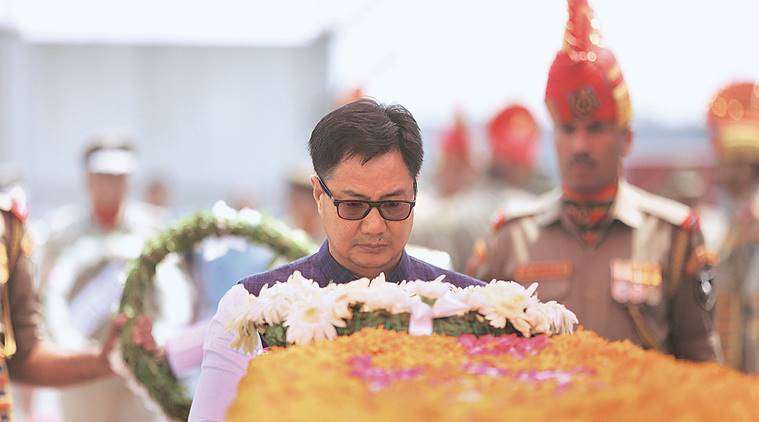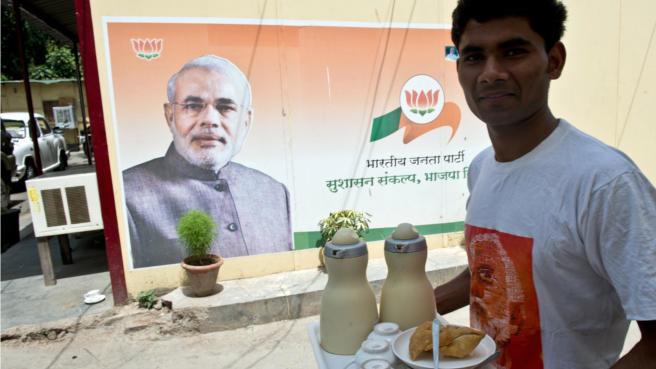May 2, 2017
The savage ambush on the Line of Control which led to the decapitation of two Indian soldiers on Monday is believed to have been authorized by Pakistan Army chief General Qamar Javed Bajwa following a visit to Pakistani military positions in Haji Pir on April 30, Indian intelligence and military sources have told The Indian Express.

May 2, 2017
The savage ambush on the Line of Control which led to the decapitation of two Indian soldiers on Monday is believed to have been authorized by Pakistan Army chief General Qamar Javed Bajwa following a visit to Pakistani military positions in Haji Pir on April 30, Indian intelligence and military sources have told The Indian Express.

MoS Home Kiren Rijiju during a ceremony to pay tributes to BSF soldier Prem Sagar in New Delhi, India, Tuesday, May 2, 2017. Express Photograph by Tashi Tobgyal
Local commanders, sources said, had underlined the need for reprisal strikes following the killing of seven to ten soldiers in an April 17 Indian artillery assault.
Lt General Nadeem Raza, who commands the Pakistan X Corps, responsible for Kashmir, pushed back against concerns that the retaliatory action could lead to escalation on the LoC, sources said, along with Major General Azhar Abbas, head of the Murree-based 12 Infantry Division, the formation whose units have been at the receiving end of the artillery duels on the LoC since last year. “Ever since the cross-Line of Control strikes that followed the Uri terrorist attack, things haven’t really quietened down” an Indian intelligence official said. “The skirmishing has been costly for Pakistan, and we think it’s trying to show India it is now willing to risk escalation, despite the weakness of its military position on the Line of Control.”
Estimated to deploy some 200,000-225,000 troops along the LoC, the Indian Army’s 15 and 16 Corps in Jammu and Kashmir have overwhelming numerical superiority against Pakistan. Pakistan’s X Corps, made up of the 23 Infantry Division, 12 Infantry Division, 19 Infantry Division and Force Command Gilgit-Baltistan, has some 100,000-125,000 troops. General Bajwa, who came to office soon after the cross-border raids ordered by Prime Minister Narendra Modi in the wake of the Uri attack, has placed Kashmir high on his agenda, visiting the Kel sector in March, and the shelling-hit Bhimber sector in December and February.
Haji Pir, the site of his April 30 visit, is a strategically-vital pass India captured in the 1965 war and then returned to Pakistan in a territory-swap, and marks the northern end of India’s Krishna Ghati sector in Mendhar, where the ambush took place Monday. Élite special forces, sources said, are believed to have monitored the Indian patrol that left Kirpan post, manned by the 200 Battalion of the Border Security Force, early in the morning, in a routine search for improvised explosive devices, knowing it would take cover in the nearest available space when machine guns and rocket-propelled grenades are fired from across the Line of Control. “The killing was over inside just a few minutes,” a BSF officer, who spoke to the two survivors, said.
The lethal ambush came days after the largest Indian fire assault since last year, targeting Pakistani posts across a large swathe of the LoC in Poonch and Rajouri. The Pakistan Army had made no official statement on the April 17 fire assault by India. However, Indian military observers estimate that up to ten Pakistani soldiers may have been killed or injured in fire directed at a position identified on Indian maps by the codename Pimple, facing Kirpan post.
Four civilians — Mohammad Shakil, Ishrat Bibi, Irum Younas and Atif Majeed — were, however, reported to have been injured in Kotli and Bhimber districts because of Indian shelling across the LoC that day. Indian military sources said the unusually heavy fire assault on Pakistani positions was ordered to retaliate after sustained fire was directed on both civilian and military positions that morning, forcing the closure of schools near the LoC in Rajouri.
Earlier skirmishing in the Rajouri-Poonch belt had led to the April 1 killing of Naib Subedar S Sanayaima Som by an improvised explosive device believed to have been laid by a Pakistan Army raiding party, while sepoy Deepak Ghadge was killed in shelling on March 9. Last November, Indian troops ambushed and killed seven Pakistani soldiers near the LoC in Sundarbani, following the decapitation of the 17 Sikh Regiment’s Sepoy Mandeep Singh. Singh’s mutilated corpse was discovered after he got separated from his patrol near the LoC ahead of Kala Post, one of several Indian forward positions in the volatile Machil sector. The killing was the first major showdown on the LoC after the post-Uri strikes.
Following the ambush in Sundarbani, Pakistan hit back, killing three Indian soldiers engaged in a counter-infiltration patrol along the Lashdat nullah in Machil, one of whose bodies was mutilated by the attackers. The onset of winter had ended skirmishing on the northern stretches of the LoC, but mortar and machine-gun fire continued to be exchanged through the spring in Rajouri and Poonch, culminating with the violence in April and May. Indian and Pakistani troops have both been accused of beheading enemy soldiers. In one gruesome August 2011 incident, Pakistan complained that three soldiers, including an officer, were beheaded in an Indian raid on a post in the Sharda sector, across the Neelum river valley in Kel. The raid is believed to have been carried out to retaliate against the decapitation of two Indian soldiers near Karnah by Pakistani special forces.
Courtesy: Indian Express
















































































































